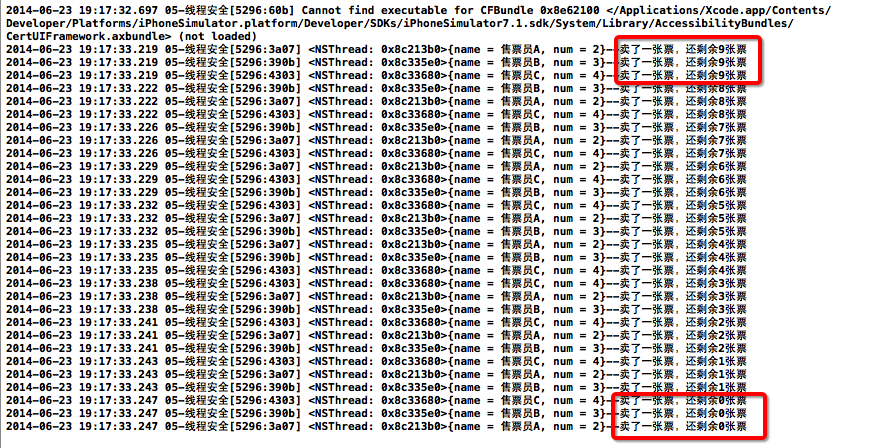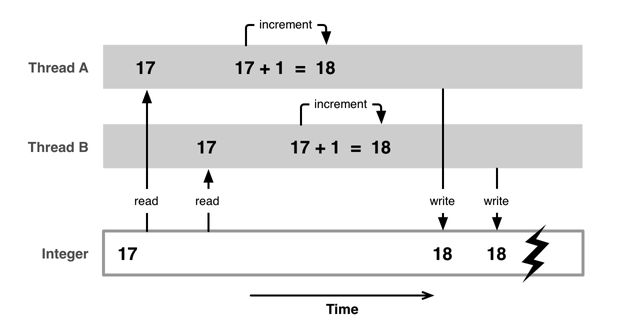一、多线程的安全隐患
资源共享
1块资源可能会被多个线程共享,也就是多个线程可能会访问同一块资源
比如多个线程访问同一个对象、同一个变量、同一个文件
当多个线程访问同一块资源时,很容易引发数据错乱和数据安全问题
示例一:

示例二:

问题代码:
1 // 2 // YYViewController.m 3 // 05-线程安全 4 // 5 // Created by apple on 14-6-23. 6 // Copyright (c) 2014年 itcase. All rights reserved. 7 // 8 9 10 #import "YYViewController.h" 11 12 @interface YYViewController () 13 //剩余票数 14 15 @property(nonatomic,assign) int leftTicketsCount; 16 @property(nonatomic,strong)NSThread *thread1; 17 @property(nonatomic,strong)NSThread *thread2; 18 @property(nonatomic,strong)NSThread *thread3; 19 20 21 @end 22 23 24 @implementation YYViewController 25 26 27 - (void)viewDidLoad 28 { 29 [super viewDidLoad]; 30 31 //默认有20张票 32 33 self.leftTicketsCount=10; 34 35 //开启多个线程,模拟售票员售票 36 37 self.thread1=[[NSThread alloc] initWithTarget:self selector:@selector(sellTickets) object:nil]; 38 39 self.thread1.name=@"售票员A"; 40 41 self.thread2=[[NSThread alloc] initWithTarget:self selector:@selector(sellTickets) object:nil]; 42 43 self.thread2.name=@"售票员B"; 44 45 self.thread3=[[NSThread alloc] initWithTarget:self selector:@selector(sellTickets) object:nil]; 46 self.thread3.name=@"售票员C"; 47 } 48 49 50 -(void)sellTickets 51 { 52 while (1) { 53 //1.先检查票数 54 int count=self.leftTicketsCount; 55 if (count>0) { 56 //暂停一段时间 57 [NSThread sleepForTimeInterval:0.002]; 58 59 //2.票数-1 60 self.leftTicketsCount= count-1; 61 62 //获取当前线程 63 NSThread *current=[NSThread currentThread]; 64 NSLog(@"%@--卖了一张票,还剩余%d张票",current,self.leftTicketsCount); 65 }else 66 { 67 //退出线程 68 [NSThread exit]; 69 } 70 } 71 } 72 73 74 -(void)touchesBegan:(NSSet *)touches withEvent:(UIEvent *)event 75 { 76 //开启线程 77 78 [self.thread1 start]; 79 [self.thread2 start]; 80 [self.thread3 start]; 81 82 } 83 84 @end
打印结果:

二、安全隐患分析


三、如何解决
互斥锁使用格式
@synchronized(锁对象) { // 需要锁定的代码 }
注意:锁定1份代码只用1把锁,用多把锁是无效的
代码示例:
1 // 2 // YYViewController.m 3 // 05-线程安全 4 // 5 // Created by apple on 14-6-23. 6 // Copyright (c) 2014年 itcase. All rights reserved. 7 // 8 9 #import "YYViewController.h" 10 11 @interface YYViewController () 12 13 //剩余票数 14 @property(nonatomic,assign) int leftTicketsCount; 15 @property(nonatomic,strong)NSThread *thread1; 16 @property(nonatomic,strong)NSThread *thread2; 17 @property(nonatomic,strong)NSThread *thread3; 18 @end 19 20 @implementation YYViewController 21 22 - (void)viewDidLoad 23 { 24 [super viewDidLoad]; 25 //默认有20张票 26 self.leftTicketsCount=10; 27 //开启多个线程,模拟售票员售票 28 29 self.thread1=[[NSThread alloc]initWithTarget:self selector:@selector(sellTickets) object:nil]; 30 31 self.thread1.name=@"售票员A"; 32 33 self.thread2=[[NSThread alloc]initWithTarget:self selector:@selector(sellTickets) object:nil]; 34 35 self.thread2.name=@"售票员B"; 36 37 self.thread3=[[NSThread alloc]initWithTarget:self selector:@selector(sellTickets) object:nil]; 38 39 self.thread3.name=@"售票员C"; 40 } 41 42 43 -(void)sellTickets 44 { 45 while (1) { 46 // ()小括号里面放的是锁对象 47 @synchronized(self){// 开始加锁,只能加一把锁 48 //1.先检查票数 49 50 int count=self.leftTicketsCount; 51 if (count>0) { 52 //暂停一段时间 53 [NSThread sleepForTimeInterval:0.002]; 54 //2.票数-1 55 56 self.leftTicketsCount= count-1; 57 //获取当前线程 58 NSThread *current=[NSThread currentThread]; 59 NSLog(@"%@--卖了一张票,还剩余%d张票",current,self.leftTicketsCount); 60 61 }else 62 { 63 //退出线程 64 [NSThread exit]; 65 } 66 } // 解锁 67 } 68 } 69 70 71 -(void)touchesBegan:(NSSet *)touches withEvent:(UIEvent *)event 72 { 73 74 //开启线程 75 [self.thread1 start]; 76 [self.thread2 start]; 77 [self.thread3 start]; 78 } 79 80 @end
执行效果图

互斥锁的优缺点
优点:能有效防止因多线程抢夺资源造成的数据安全问题
缺点:需要消耗大量的CPU资源
互斥锁的使用前提:多条线程抢夺同一块资源
相关专业术语:线程同步,多条线程按顺序地执行任务
互斥锁,就是使用了线程同步技术
四:原子和非原子属性
OC在定义属性时有nonatomic和atomic两种选择
atomic:原子属性,为setter方法加锁(默认就是atomic)
nonatomic:非原子属性,不会为setter方法加锁
atomic加锁原理
1 @property (assign, atomic) int age; 2 3 - (void)setAge:(int)age 4 { 5 6 @synchronized(self) { 7 _age = age; 8 } 9 }
原子和非原子属性的选择
nonatomic和atomic对比
atomic:线程安全,需要消耗大量的资源
nonatomic:非线程安全,适合内存小的移动设备
iOS开发的建议
所有属性都声明为nonatomic
尽量避免多线程抢夺同一块资源
尽量将加锁、资源抢夺的业务逻辑交给服务器端处理,减小移动客户端的压力